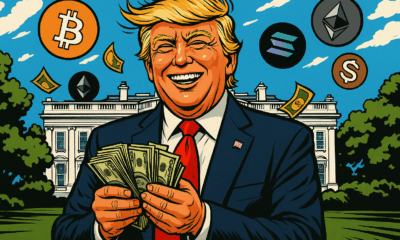Blockchain & DeFi
“Stablecoins Will Save the U.S. Dollar”: Bold Claim, Big Questions

- Share
- Tweet /data/web/virtuals/383272/virtual/www/domains/theunhashed.com/wp-content/plugins/mvp-social-buttons/mvp-social-buttons.php on line 63
https://theunhashed.com/wp-content/uploads/2025/09/wlf-1000x600.png&description=“Stablecoins Will Save the U.S. Dollar”: Bold Claim, Big Questions', 'pinterestShare', 'width=750,height=350'); return false;" title="Pin This Post">
When Eric Trump recently told the New York Post that stablecoins could “save the U.S. dollar,” the remark drew both intrigue and skepticism. As the intersection of crypto, monetary policy, and political power becomes more contested, that statement is far more than mere crypto‑PR. It raises serious questions about the future of money, the role of private actors in currency issuance, and the fragile balance of trust in the financial system.
From Stabilizing Crypto to “Saving” the Dollar
Eric Trump’s assertion comes in the context of his family’s backing of USD1, a stablecoin tied to the Trump-family crypto project, World Liberty Financial (WLFI). According to reports, Eric believes that stablecoins offer a way to preserve—or even enhance—the dominance of the U.S. dollar.
The logic goes something like this: as digital currencies mature, stablecoins, which anchor their value to a reference like the U.S. dollar, could allow more economic activity to occur on blockchain rails—thus extending the dollar’s reach in global commerce, payments, and transactions. In his telling, stablecoins become a modern vessel carrying the dollar into the digital age.
But turning a payment instrument into the savior of national currency is a leap. The claim invites scrutiny on multiple fronts: economics, regulatory oversight, conflict of interest, and global monetary dynamics.
Conflict of Interest on Center Stage
One of the most immediate tensions in Eric Trump’s claim is the overlap between private interest and public authority. Critics in Washington have already sounded alarms. In March, five Democratic senators warned that a sitting President’s stakes in a stablecoin project could pose “unprecedented risks” to the integrity of the financial system. Representative Maxine Waters went further, arguing that the Trump family might aim to replace the U.S. dollar in government disbursements—such as Social Security payments and tax refunds—with their own stablecoin. Other detractors note that there is little to prevent the President or his affiliates from profiting from the issuance, usage, and regulation of such a coin.
In short, when the line between state power and private currency issuance blurs, the risk of favoritism, regulatory capture, or even monetary manipulation becomes a real and present concern.
Does the Idea Make Economic Sense?
Supporters of the idea that stablecoins can help preserve the dollar’s dominance point to several factors. They argue that a widely adopted, regulated stablecoin could enable broader access to dollar-denominated value, especially in underserved or underbanked regions. This could foster greater financial inclusion on a global scale.
They also highlight the inefficiencies of legacy financial systems, which are often slow, expensive, and siloed. A well-designed stablecoin infrastructure, they argue, might reduce transaction costs, accelerate settlement times, and increase interoperability across platforms and borders.
Perhaps most significantly, they claim that stablecoins could help defend the dollar’s global status. As other countries experiment with digital-native monetary systems, U.S.-backed stablecoins could embed the dollar into the future of global finance. Eric Trump is not alone in this thinking; Federal Reserve Governor Christopher Waller has expressed similar sentiments about stablecoins expanding the dollar’s reach.
However, critics see a different picture. Some worry that stablecoins could act as a Trojan horse, allowing private entities to siphon demand away from traditional banks and central banks. The European asset manager Amundi has warned that weak regulation around stablecoins might actually undermine, rather than reinforce, long-term dollar dominance. Moreover, the stability and credibility of a currency are not guaranteed by mere digital replication. They depend on trusted governance, robust backing, and transparency—qualities that are not always evident in privately issued tokens.
What Regulation Is Already in Motion?
Despite these concerns, the Trump administration has moved forward with regulatory steps. In July, it signed into law the GENIUS Act, which aims to regulate stablecoins in the U.S. Yet many lawmakers believe this legislation does too little to address potential conflicts of interest, especially when politically connected entities are involved in issuing these digital assets.
Senators including Elizabeth Warren, Chris Van Hollen, and Ron Wyden have publicly voiced concerns that the law does not provide sufficient safeguards to prevent insiders from exploiting the system for personal gain. As it stands, regulators are facing a complex dilemma: how to encourage innovation in digital payments while maintaining financial stability, preventing abuse, and preserving the Federal Reserve’s authority over the monetary system.
The Deeper Stakes: Who Controls the Money
This debate goes beyond crypto hype or partisan posturing. At its core, it’s about monetary sovereignty and the structure of trust in the financial system. If politically affiliated private organizations begin issuing widely adopted dollar-pegged tokens, they could effectively challenge the Federal Reserve’s control over money supply and systemic stability.
If regulation proves inadequate or gets captured by special interests, these tokens could introduce fragmentation, create new forms of shadow banking, or pose systemic risks that regulators are ill-prepared to manage. The public’s trust in the currency—historically anchored in central bank independence—could erode if money becomes too entangled with political ambition.
Conclusion: Grand Vision or Dangerous Gamble?
Eric Trump’s bold proclamation—that stablecoins will save the U.S. dollar—offers a provocative vision of the future. It taps into genuine excitement around the potential of tokenization, financial inclusion, and the modernization of payments. But slogans are not strategies, and digital optimism alone won’t secure monetary supremacy.
Real-world adoption of stablecoins involves high stakes. It requires regulatory clarity, public trust, strong institutional governance, and insulation from political opportunism. Without these guardrails, stablecoins might not save the dollar—they might destabilize it.
Whether Eric Trump’s vision becomes a breakthrough or a cautionary tale will depend not just on innovation, but on accountability.
Blockchain & DeFi
Exodus Goes Full Stack: Wallet Giant Acquires W3C to Dominate Crypto Payments

In a major leap toward integrating self-custody wallets with everyday finance, Exodus Movement has signed a $175 million deal to acquire W3C Corp, the parent company of crypto-friendly payment providers Baanx and Monavate. The acquisition puts Exodus squarely on the path to becoming a vertically integrated player in the crypto payments ecosystem—controlling everything from asset storage to transaction rails.
Wallet meets payments infrastructure
Exodus has built its brand on providing sleek, user-friendly wallets that give users full custody of their digital assets. But this move signals a new ambition: to turn those wallets into true financial hubs, enabling users not only to hold crypto but to spend it with the same ease as fiat currency.
With Baanx and Monavate now under its umbrella, Exodus gains direct access to critical infrastructure like card issuing, transaction processing, and compliance frameworks. That means Exodus users could soon swipe a debit card backed directly by their on-chain assets, or access stablecoin payments seamlessly integrated into the app.
This isn’t about being another crypto wallet. It’s about being the first wallet that also functions like a bank.
Terms of the deal and financing
The acquisition, expected to close in early 2026, is financed through a mix of cash and credit. Exodus is securing funding via a lending facility with Galaxy Digital, backed in part by its Bitcoin holdings. This is both a savvy move and a calculated risk—using crypto collateral in a volatile market can amplify upside, but also exposes the company to market drawdowns.
Still, the message is clear: Exodus is betting on Bitcoin long term, and is leveraging its own balance sheet to double down on crypto-native financial infrastructure.
Strategic shift: from holding to spending
What makes this deal so significant is the directional shift it signals. Most wallets—hardware or software—have stopped short of solving the everyday usability problem. People can hold assets, but spending them usually requires off-ramping through exchanges, third-party cards, or custodians.
By contrast, Exodus now controls a vertically integrated stack that could take a user from cold storage to tap-to-pay in seconds. If executed well, it could mark a major evolution in self-custody—from a niche security practice to a full-featured alternative to traditional banking.
It also opens the door to stablecoin integration, programmable payments, and more advanced DeFi access—all without compromising user control of private keys.
Risk profile: market exposure and compliance
Of course, there are headwinds. The integration of payments infrastructure is complex, especially in jurisdictions where financial compliance is stringent and ever-changing. Onboarding new users, securing licenses, maintaining AML/KYC standards, and building regulatory trust takes time and resources.
There’s also the financing risk. Tying operational runway to crypto market cycles—via Bitcoin-backed credit lines—creates a dependency that can be both a strength and a vulnerability. A bull market could supercharge the project. A correction could tighten liquidity.
But Exodus seems prepared to manage these variables, signaling confidence not just in crypto’s long-term growth, but in its own ability to lead the transition from speculative assets to everyday utility.
What it means for the industry
This acquisition is more than just M&A. It’s an evolution in crypto’s UX. If Exodus can successfully build a wallet that handles custody, compliance, payments, and user experience under one roof, it may set the standard for a new category of fintech.
It could also pressure traditional banks and fintechs to integrate crypto more deeply, or risk being leapfrogged by crypto-native services that offer better speed, lower fees, and superior global access.
Final thoughts
Exodus isn’t just adding features—it’s laying down rails for a self-sovereign financial system. The acquisition of W3C may look like a backend infrastructure play, but it’s really a front-end transformation of how people use money. Wallets are no longer just vaults. They’re becoming launchpads.
Blockchain & DeFi
When DeFi Becomes Finance: How Token Buybacks Are Reshaping Governance at Uniswap, Lido and Aave

The decentralized‑finance sector is increasingly borrowing cues from Wall Street: protocols such as Uniswap, Lido and Aave are deploying token‑buyback strategies that mirror corporate stock repurchases. That shift may come at the cost of decentralization.
From incentives to buybacks
In the early DeFi era, growth was fuelled by liquidity mining, yield farming and community token distribution. But a notable pivot is underway: Uniswap’s “UNIfication” governance proposal seeks to activate previously dormant protocol fees, route them into a treasury engine and use the proceeds to buy back and burn its native token UNI. That move shifts UNI’s role from purely governance to something closer to economic equity. Similarly, Lido has introduced a mechanism tying buybacks of its LDO token to thresholds such as Ethereum’s price and annual revenue. These initiatives signal a broader shift in DeFi from incentive‑driven issuance to revenue alignment and token scarcity.
Centralization under the hood
While buybacks may enhance token value, they also raise governance implications. When a protocol channels revenue into buybacks, decision‑making tends to centralize: fewer tokens outstanding mean fewer holders exerting power, and governance debates can shrink in scope. Uniswap’s UNIfication proposal notably transfers operational control from the community foundation to a core entity, raising questions about how decentralized the system truly remains. That change has ignited pushback from analysts who argue that concentration of power threatens the original ethos of decentralization.
Institutional logic meets decentralised platforms
These buyback programs bring traditional‑finance metrics into DeFi: concepts like yield thresholds, fee capture and token‐supply control are now front and centre. Protocols are acting less like open‑source networks and more like growth companies with value propositions. As one observer noted, the sector is moving from “free experimentation” and “cultural hype” toward “balance‑sheet clarity” and “corporate discipline.” But this evolution also ushers in tension: the community’s demand for openness and collective governance may clash with a finance‑style focus on token value and scarcity.
Risks in disguise
The financial logic is easy to follow, but the governance logic is more complex. Buybacks may temporarily boost token value, but they don’t guarantee sustainable business performance—especially in cyclic markets. Analysts caution that many of these programs rely on treasury reserves rather than recurring revenue streams, which may leave protocols vulnerable in a downturn. More fundamentally, allocating large sums to buybacks can deprioritise innovation, open‑source development and liquidity growth in favour of financial engineering. Lastly, regulators may begin to interpret large token buybacks as dividend‑like distributions, posing legal and compliance risks for protocols that skirt traditional securities frameworks.
What to watch
Going forward, key signals to monitor include how each protocol implements buyback mechanics: whether buybacks are triggered automatically based on transparent rules, or managed ad‑hoc by governing entities. The behaviour of token governance (voter turnout, proposal volume) will also offer insight into centralisation trends. Finally, how token value holds in a downturn will test whether these buyback models represent sustainable economic design or just gimmicks layered on top of crypto’s hype cycle.
Conclusion
The wave of token buybacks by major DeFi protocols marks a turning point. On one hand, it signifies maturation: revenue‑driven models, token‑economies aligned to business outcomes and more familiar investment frameworks. On the other hand, the shift raises core questions about decentralization, governance and the role of community in shaping protocol outcomes. As DeFi continues its evolution, the trade‑off between efficient capital models and autonomy will define the next chapter.
Blockchain & DeFi
Japan’s Banks and Regulator Move Boldly on Yen‑Stablecoin Launch

In a striking push for financial innovation, Japan’s regulatory authority has thrown its weight behind a collaborative initiative by the nation’s largest banks to launch a yen‑backed stablecoin. As Japan positions itself at the frontier of payments and digital finance, this marks a critical turning point in how traditional institutions and blockchain converge.
A new era of payments: regulator says yes
The Financial Services Agency (FSA) of Japan has officially endorsed what it calls its “Payment Innovation Project” — a scheme that brings together major banks and corporate players to issue a yen‑denominated stablecoin. According to the announcement, the project begins this month, and the immediate goal is to pilot payment‑stablecoin use among corporate clients.
Participants include Mizuho Bank, MUFG Bank (via its issuance platform “Progmat”), Sumitomo Mitsui Banking Corporation, and Mitsubishi Corporation alongside its financial arm.
The FSA emphasizes that the move responds to a broader trend: the use of blockchain technology to enhance payment systems and corporate settlement frameworks. It also indicated that after the pilot phase, results and conclusions will be published — meaning the regulator wants transparency and oversight from the start.
Why this matters
This development is significant in several key ways.
Firstly, it signals institutional acceptance of stablecoins within a regulated banking environment — not just in cryptocurrencies or niche use‑cases. By backing a yen‑stablecoin initiative, Japan is saying stablecoins deserve a seat at the table of mainstream finance.
Secondly, the collaboration among major banks matters because they serve hundreds of thousands of corporate clients in Japan. The participating banks and firms collectively serve more than 300,000 corporate users. That means this isn’t a small pilot of a handful of users; it has potential scale and could meaningfully impact corporate treasury, cross‑border settlement, and payment efficiency.
Thirdly, for the broader stablecoin and digital‑asset ecosystem, this is a signal that regulatory acceptance paired with traditional banking infrastructure may accelerate adoption. If banks issue — or co‑issue — stablecoins under the oversight of a regulator like the FSA, then the “wild‑west” narrative of crypto may shift toward “bank‑backed digital money” narratives.
Strategic implications for banks and corporates
For the banks involved, launching a stablecoin gives them a dual opportunity: one, to modernize their internal and cross‑corporate settlement operations, and two, to position themselves as platform providers for digital‑asset infrastructure rather than mere intermediaries. For corporates, the promise is lower settlement friction, more real‑time settlement (or closer), and potential cost savings.
However, this is not without challenges. The banks will need to ensure seats at the table for compliance, reporting, reserve transparency (for the coin‑backing), user protection, operational risk (smart‑contract bugs, blockchain outages, etc.), and possibly new regulatory frameworks. The FSA explicitly stressed the need to ensure users are protected and informed.
What the pilot will test and next steps
The pilot phase begins with issuance of payment‑stablecoins by the banks in question. They will likely test transactions among corporate clients, gauge settlement speed, examine cost savings, user experience, and perhaps integration with broader payment rails. Key metrics will probably include transaction volume, error/risk events, compliance overhead, effects on liquidity/reserve management, and customer uptake.
Following completion, the Japanese regulator intends to publish results and conclusions. That transparency will matter widely, as other jurisdictions and digital‑asset players will watch for lessons learned.
Broader regulatory and industry context
This initiative comes amid a broader wave of regulatory openness and crypto‑fintech experiments in Japan. The FSA and other Japanese regulators have recently been active in reviewing regulation for crypto, including considering whether banks can hold crypto, and addressing issues like insider trading in crypto markets.
Japan’s influential role here may serve as a model for other banking systems where stablecoins are considered more than speculative tokens and instead digital representations of fiat‑value for everyday payment and settlement.
Risks and considerations
Even with regulatory backing and major bank involvement, several caveats remain. It’s still early days, so operational glitches could occur — blockchain failures, integration issues with legacy systems, or unanticipated regulatory burdens. The banks will also need to navigate reserves and backing transparency: if the stablecoin is truly backed 1:1 by yen or equivalent assets, reserve audits will be important. They must also address AML/KYC and cross‑border legal issues if the stablecoin is used internationally.
Another consideration is whether corporates will adopt in meaningful volume — changing behavior from existing payment methods (bank transfers, commercial paper, etc.) takes time. And finally, competition could come from non‑bank stablecoins or global stablecoin initiatives, meaning banks must differentiate on trust, integration and regulation.
What to watch
In the coming weeks and months, it will be important to watch for when the banks issue the stablecoin, how many corporates sign up, what volume is processed, how settlement times compare to legacy methods, and whether the project expands beyond domestic corporate clients into cross‑border flows or retail use. Also of interest: how the FSA evaluation is structured and what transparency requirements are imposed.
For the crypto industry more broadly, this could signal an acceleration of tokenized fiat led by regulated banks — possibly raising the bar for stablecoin projects and redefining competition from un‑backed or lightly‑backed tokens toward bank‑backed or regulated stablecoins.
-

 Cardano2 months ago
Cardano2 months agoCardano Breaks Ground in India: Trivolve Tech Launches Blockchain Forensic System on Mainnet
-

 Cardano2 months ago
Cardano2 months agoCardano Reboots: What the Foundation’s New Roadmap Means for the Blockchain Race
-

 Cardano2 days ago
Cardano2 days agoSolana co‑founder publicly backs Cardano — signaling rare cross‑chain respect after 2025 chain‑split recovery
-

 Bitcoin2 months ago
Bitcoin2 months agoQuantum Timebomb: Is Bitcoin’s Foundation About to Crack?
-

 Cardano2 months ago
Cardano2 months agoAfter the Smoke Clears: Cardano, Vouchers, and the Vindication of Charles Hoskinson
-

 Cardano2 months ago
Cardano2 months agoMidnight and Google Cloud Join Forces to Power Privacy‑First Blockchain Infrastructure
-

 Ripple2 months ago
Ripple2 months agoRipple CTO David “JoelKatz” Schwartz to Step Down by Year’s End, but Will Remain on Board
-

 News2 months ago
News2 months agoRipple’s DeFi Awakening: How mXRP Is Redefining the Role of XRP













